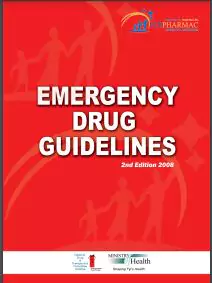‘List of Emergency Drugs And Their Actions’ PDF Quick download link is given at the bottom of this article. You can see the PDF demo, size of the PDF, page numbers, and direct download Free PDF of ‘List of Emergency Drugs and their Actions’ using the download button.
Emergency Drugs Guidelines PDF Free Download

List of Emergency Drugs And Their Actions
This section is intended as a brief guide to some of the drugs mentioned in this book. It is by no means exhaustive and does not cover all contraindications or dosage alterations in special situations.
Information about these areas should be obtained elsewhere. The dosages below are guides only. Drug therapy should always be adjusted to the individual patient’s situation.
1.1 Local Anaesthetics Local anesthetic agents are used to provide anesthesia through local wound infiltration, nerve blocks, or regional techniques. Side effects from systemic absorption include seizures and cardiac arrhythmias.
Avoid accidental intravenous administration by aspirating for blood before injection. Lignocaine is the agent of choice for local wound infiltration.
The 1% solution is suitable for local infiltration of most wounds. A concentration of 2% should be used for digital nerve blocks and any other area where a smaller volume of anesthetic is desirable.
Lignocaine with adrenaline should not be used on the extremities, i.e. nose, fingers, toes, ears, or penis.
The addition of adrenaline helps control bleeding and also extends the duration of anesthesia. Ketamine has anesthetic and analgesic properties and is less likely to produce hypotension than other sedative agents.
It also has a mild bronchodilator action which makes it useful when anaesthetising patients with asthma. Adverse effects include increased salivation, laryngospasm, raised intracranial pressure, and unpleasant hallucinations after recovery of consciousness.
Ketamine should not be used in patients at risk of raised intracranial pressure (e.g. head injuries, meningitis) or in patients with ischaemic heart disease.
It should not be given unless personnel and facilities are available to protect the patient’s airway. Ketamine should be given as an intravenous bolus.
The usual dose is 2 mg per kg although some patients may require larger amounts. The onset of action is within 60 seconds and the duration is about 20 minutes.
Thiopentone is a barbiturate with a short action because of rapid distribution. Its main adverse effects relate to cardiorespiratory depression.
It should be used with great care in patients who are hypotensive and should not be given unless personnel and facilities are available to protect the patient’s airway. It is a potent anticonvulsant and is the drug of choice for anesthetizing patients with status epilepticus.
Thiopentone should be given as an intravenous bolus. The usual dose is 3 to 5 mg per kg. The lower dose should be used in the elderly.
The onset of action is about 30 seconds and its effects last for 5 to 10 minutes.
Midazolam is a short-acting benzodiazepine. It has powerful amnestic properties and produces less cardiorespiratory depression than thiopentone. It is a fairly safe and useful anesthetic induction agent in the critically ill and is also used to sedate children and agitated patients.
Midazolam can be given intramuscularly or as an intravenous bolus. In children, intranasal midazolam is a useful premedication before suturing.
The onset of action of intravenous midazolam is 1 to 2 minutes and the effects of a single dose last from 60 to 90 minutes. Intranasal midazolam has its maximal effect within 10 minutes and lasts up to 2 hours.
In ADULTS: The intravenous dose is 2.5 to 15 mg. The dose should be titrated to its effect. Smaller doses are usually required for the elderly, whereas alcoholics may require higher doses.
The intramuscular dose is 5 to 10 mg. In CHILDREN: The intravenous dose is 0.15 to 0.3 mg per kg up to 0.5 mg per kg.
The intranasal dose is 0.2 to 0.4 mg per kg (to a maximum of 5 mg), slowly dropped into alternate nostrils 1.3 Anticholinergics Anticholinergic drugs block the effects of acetylcholine at muscarinic receptors.
The most commonly used anticholinergic agent is atropine. This drug is used for the treatment of bradycardia due to increased vagal tone, to block the cholinergic effects of drugs such as suxamethonium in children, and to reverse some of the adverse effects of anticholinesterase (organophosphate) poisoning.
Ipratropium is used in the treatment of asthma and benztropine is used in the treatment of oculogyric crisis. Atropine should be used with care in patients with ischaemic heart disease as it may cause marked sinus tachycardia. The usual adult dose is 0.6 mg intravenously as a bolus, repeated in 5 minutes if necessary.
A dose of 3 mg will produce a complete blockade of muscarinic cholinergic receptors in an adult. Much larger doses are used in anticholinesterase poisoning.
Atropine may be given via the endotracheal tube in an emergency; use twice the normal intravenous dose and dilute in 10 ml of 0.9% saline.
The pediatric dose is 20 micrograms per kg (to a maximum of 0.5 mg). The onset of action is within 5 minutes and the duration of action is 2 to 4 hours. Benztropine is used in the treatment of oculogyric crises precipitated by prochlorperazine or similar drugs.
Overdose of benztropine can cause central anticholinergic syndrome (confusion, hallucinations). The usual dose in adults is 1 to 2 mg orally or intramuscularly.
Children should be given 20 micrograms per kg. Its duration of action is shorter than most of the drugs that cause oculogyric crisis so a repeat oral dose should be given 4 hours after the initial dose.
| Author | Ministry of Health Government |
| Language | English |
| No. of Pages | 150 |
| PDF Size | 1.5 MB |
| Category | Health & Fitness |
| Source/Credits | health.gov.fj |
Related PDFs
List of Emergency Drugs And Their Actions Book PDF Free Download
